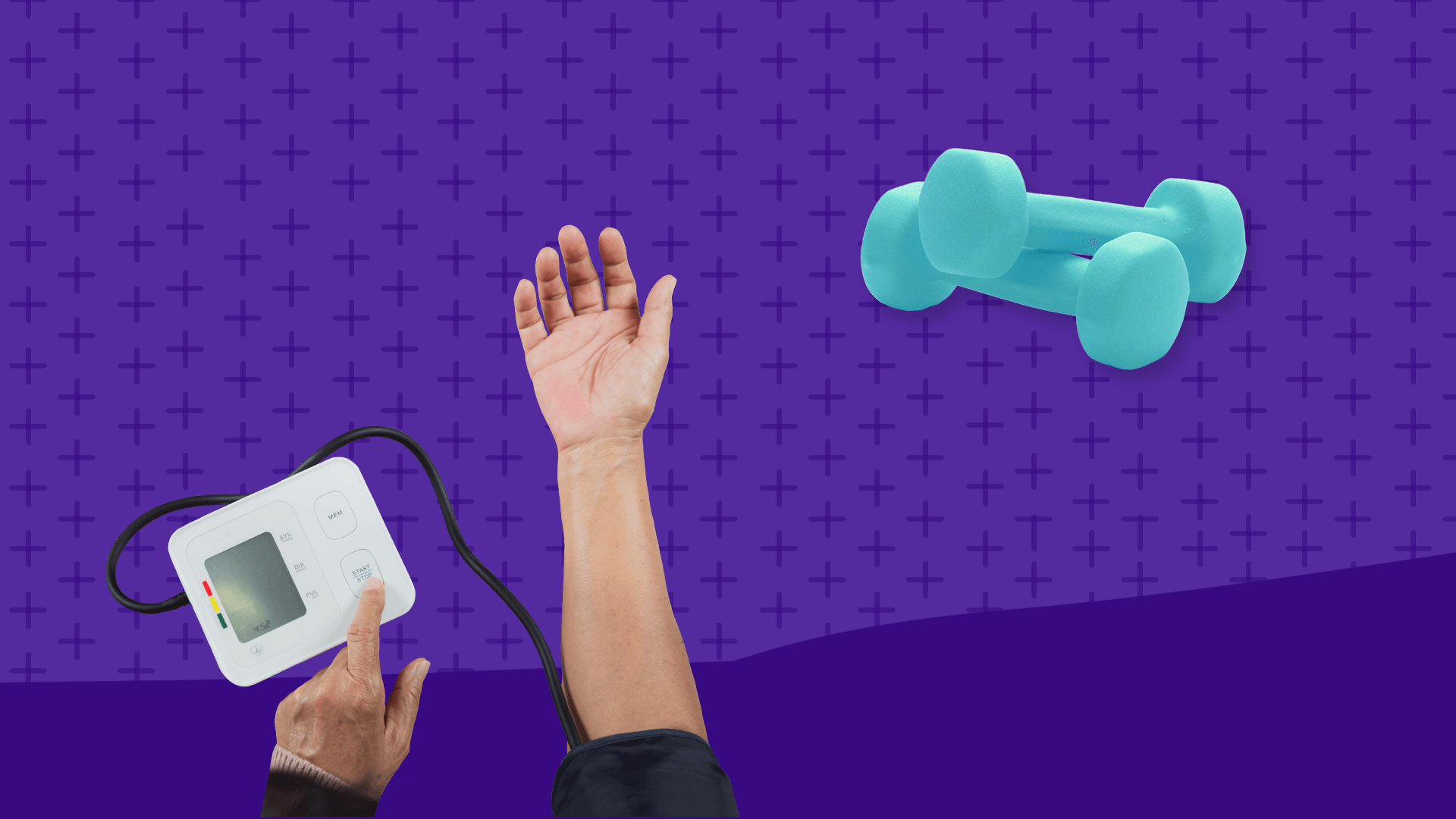Key takeaways
Regular exercise significantly lowers the risk of developing chronic diseases such as diabetes, high blood pressure, high cholesterol, osteoporosis, dementia, and certain types of cancer.
Engaging in at least 150 minutes of moderate cardiovascular activity weekly, combined with strength training twice a week, can prevent or manage chronic health conditions.
Exercise not only helps in reducing the need for certain medications but also improves overall well-being and mental health.
Starting slow with any amount of physical activity and gradually increasing it is beneficial, but it’s important to consult with a physician before beginning any vigorous exercise program, especially after a period of inactivity.
You know that exercise is good for you, but you just can’t find the time to squeeze in a workout. Here’s a little extra motivation to get moving: A regular fitness routine has far-reaching health benefits. People who are physically active are much less likely to develop chronic health conditions than those who don’t exercise. What’s more, if you already have one of these conditions, exercise is a great way to manage or reverse your symptoms. Here, experts explain how exercise and disease prevention go hand-in-hand.
6 chronic diseases prevented by exercise
“Exercise has positive effects on virtually every cell in the body,” says Glenn Gaesser, Ph.D., fellow of the American College of Sports Medicine and professor at The College of Health Solutions at Arizona State University. Physically active people are less likely to develop chronic diseases, whereas sedentary people are at increased risk of virtually every major chronic illness. “Even if exercise does not ‘cure’ the disease, people with chronic health conditions (e.g., diabetes, high blood pressure, and high cholesterol) who exercise regularly will reduce their risk of dying from those conditions,” Gaesser says.
“I’ve had patients stop or decrease their cholesterol, blood pressure, or diabetes medications when I’m able to counsel them on how their diet and exercise plan affects their health status,” says Eric Ascher, DO, an attending physician at Northwell Health, Family Medicine in New York. Others are often able to decrease the doses of their medication.
1. Diabetes
There’s a direct inverse correlation between exercise and diabetes. “When I have patients whose blood sugar is up, I ask them to walk after their largest meal, because in order for your muscles to work they need some glucose,” says Kathryn A. Boling, MD, primary care provider at Mercy Personal Physicians in Lutherville, Maryland. “[Exercise] draws glucose out of the bloodstream and into the muscles. That lowers your blood sugar, which makes it less likely that your diabetes is going to be out of control, or that you’re even going to get diabetes.”
In other words, staying active has a similar effect to medications like insulin on your blood sugar levels. It can help to naturally decrease hyperglycemia and lessen the need for medication for some patients.
RELATED: Can you reverse diabetes?
2. Anxiety and depression
Exercise, particularly cardio-based movements, boosts your endorphins, the feel-good hormones made by your body. This promotes nerve and cellular growth, which research shows relieves depression and anxiety. “For my patients who are anxious or depressed, I always recommend an exercise regimen along with therapy or medicine if needed,” Dr. Ascher says.
Exercising outdoors offers even greater benefits. “Being outside in nature is good for your soul, and it helps people feel better,” says Dr. Boling. Studies show that working out in nature improves psychological well-being.
RELATED: Is it safe to exercise while taking Xanax?
3. High blood pressure
Exercise can have a huge impact on patients with hypertension. That’s because the heavier you are, the more your risk increases. “If people with high blood pressure go on a better eating program, start exercising, and lose some weight, sometimes they can drop their medicines down, or even come off their blood pressure medicine,” says Dr. Boling. That could mean a lower dosage of medication, or even reaching a healthy blood pressure range that doesn’t require a prescription.
RELATED: How to safely exercise with high blood pressure
4. High cholesterol
Many people are able to lower their cholesterol without drugs simply by adopting an exercise routine and making other lifestyle changes, according to the Centers for Disease Control and Prevention (CDC).
“Cardio-based exercise routines are going to get the blood flowing and your heart pumping, and that is definitely helpful in regards to weight loss and improvement of your heart health, both aspects of reversing heart disease, high cholesterol, and diabetes,” says Dr. Ascher.
RELATED: How to lower cholesterol
5. Osteoporosis
Weight-bearing exercise is important for everyone, especially as we age. “For women in particular, osteoporosis is a big problem; you don’t want to get to 70 and all of a sudden your bones are so fragile that you fall down … and you fracture your hip,” Dr. Boling says.
Lifting weights or engaging in weight-bearing exercise stresses your bones, causing them to draw in more calcium. That makes bones harder and decreases your risk of osteoporosis or osteopenia in the future.
5. Dementia
People with chronic diseases are much more likely to develop dementia. “Just having your sugar and your blood pressure be in a normal range really makes a difference in dementia. If you have high sugar it’s not only affecting your body, but it also affects your brain,” says Dr. Boling. Additionally, poorly managed chronic diseases can worsen cognitive impairment, according to the CDC.
6. Cancer
Exercise reduces the risk of cancer through a number of mechanisms. “Overall, cancer risk is reduced by the beneficial effects of exercise on insulin and insulin-like growth factors, and by reducing risk of chronic inflammation,” Gaesser says.
Because being obese increases your risk of certain cancers, incorporating exercise into your routine can decrease your risk by helping you maintain a healthy weight, adds Dr. Boling.
How much exercise do you need?
When it comes to physical activity and chronic disease, you may be wondering how much activity is required each week to reap it’s disease-preventing benefits. The CDC recommends a minimum of 150 minutes of moderate cardiovascular activity (such as walking) each week, or 75 minutes of higher intensity exercise (like running or biking) weekly. This should be in combination with at least two days of weight training targeting all of your major muscle groups (back, hips, legs, arms, shoulders, and abdomen).
If you’re just starting out, any amount of activity is going to help you. “If you only [exercise] for 15 minutes, you’re benefiting yourself,” says Dr. Boling. “And the more you do that, the more likely you are to be willing to do it for longer.” Start slow and build up incrementally. If you add a minute or two each week, you’ll be hitting your goals before you know it.
Cardiovascular exercise is probably best overall for treating or reducing risk of chronic conditions, whereas strength training is essential for maintaining or increasing muscle mass and strength. “Strength training also improves functional fitness and reduces risk of bone loss (osteopenia) and muscle loss (sarcopenia), reducing the risk of frailty,” Gaesser says.
Symptoms that warrant a break from exercise
If you’re in excruciating pain of any kind, stop what you’re doing. “If you have chest pain when you’re exercising—especially if it’s accompanied by shortness of breath or really heavy sweating—stop exercising and contact your doctor right away,” Dr. Boling says.
If you’ve been very sedentary for a long period of time, consult with your physician before starting a program of vigorous-intensity exercise. Although most people can incorporate moderate-intensity activity without worrying about risk of complications, it is best to be safe and check with your doctor first.
“Fatigue and soreness may indicate too much exercise,” Gaesser says. “If you’re just beginning an exercise program, a little muscle soreness is natural, but it usually goes away within a week. The key is to gradually increase the dose of exercise (i.e., intensity, duration, frequency).”
If you experience any sharp pains in your muscles or joints that don’t go away, seek medical attention. If an exercise doesn’t feel right or is uncomfortable in any way, it might not be right for you. There are plenty of options or modifications you can make.











